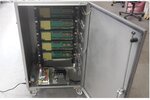doncarlosalbatros
Full Member level 2
Is there a workaround for power supply not local with receiver input?
I'm stuck with an issue.. A 0-5V 33Hz pulse train need to be interfaced with an optocoupler 4N46 before it reaches to a DAQ input. This is need to block common mode EMI which introduces noise at this DAQ's input.

If you look at my drawing, if I interface an optocoupler between the Arduino and the DAQ input, I have to use a separate power supply for the opto output 5V Vcc in the diagram. That is fine but I will not be able to locate the power supply close to the DAQ input. I mean after the optocoupler output there will be a two wire cable max 100cm long upto the point receiving input.
Since the supply for the opto is not at the receiving board, I'm afraid to introduce a new ground loop. DAQ is a bit high 100cm above and I'm not sure it has 5V supply built in. Here is a photo you can see the DAQ boards are stacked and the supplies are on the ground of the big enclosure:

Is there any workaround for this problem? I can make the opto board close to the DAQ input, but if the DAQ has no supply the power supply for the opto can only be on the ground of the big enclosure. I can use STP wires or purchase any kind of supply but don't know what could be the proper approach.
Thanks in advance.
I'm stuck with an issue.. A 0-5V 33Hz pulse train need to be interfaced with an optocoupler 4N46 before it reaches to a DAQ input. This is need to block common mode EMI which introduces noise at this DAQ's input.

If you look at my drawing, if I interface an optocoupler between the Arduino and the DAQ input, I have to use a separate power supply for the opto output 5V Vcc in the diagram. That is fine but I will not be able to locate the power supply close to the DAQ input. I mean after the optocoupler output there will be a two wire cable max 100cm long upto the point receiving input.
Since the supply for the opto is not at the receiving board, I'm afraid to introduce a new ground loop. DAQ is a bit high 100cm above and I'm not sure it has 5V supply built in. Here is a photo you can see the DAQ boards are stacked and the supplies are on the ground of the big enclosure:

Is there any workaround for this problem? I can make the opto board close to the DAQ input, but if the DAQ has no supply the power supply for the opto can only be on the ground of the big enclosure. I can use STP wires or purchase any kind of supply but don't know what could be the proper approach.
Thanks in advance.
Last edited:


